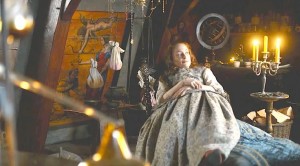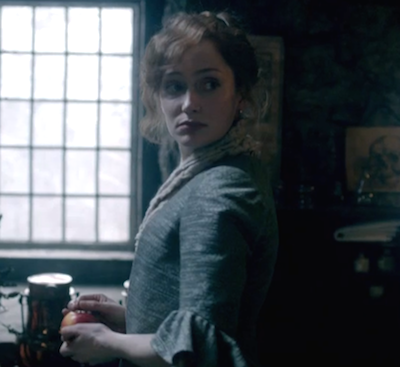This post will be about summarizing some of the references describing Geillis as a white lady in order to lay the foundation for subsequent posts that will discuss the following issues:
- The connection between the Duke of Sandringham and Geillis Duncan
- The association between Joe Abernathy and his ancestor, Ishmael
- Geillis’ association with men of “dark” nature
- Geillis suffering from syphilis
At the same time, there will be a comparison between Claire and Geillis to establish major differences. Most of the references belong to the third book of the series, Voyager.
Claire as a White Lady
“My wife was a healer. What they call in the Highlands a charmer, but more than that. She was a white lady – a wise-woman.” He glanced up briefly. “The word in Gaelic is ban-druidh; it also means witch.” (Gabaldon, “Voyager” 163-164)
“Some o’ the auld women at Lallybroch say ye were a wisewoman – a white lady, or maybe even a fairy. When uncle Jamie came home from Culloden without ye, they said as how ye’d maybe gone back to the fairies, where ye maybe came from. Is that true? D’ ye live in a dun?” (Gabaldon, “Voyager” 422)
“The witch. She is a soul-eater. She is death. He is dead, the MacKenzie, he is dead.” (Gabaldon, “Voyager” 146)
“The gold is cursed. Do ye be warned, lad. It was given by the white witch, given for the King’s son. But the cause is lost, and the King’s son fled, and she will not let the gold be given to a coward.” (Gabaldon, “Voyager” 146)
“She seeks a brave man. A MacKenzie, it is for Himself. MacKenzie. It is theirs, she says it, for the sake of him who is dead.” (Gabaldon, “Voyager” 146).
“Aye, I ken weel enough how it’s been for ye. She’s worked the same sorcery on me, betimes.” His eyes raked over me, burning. “A murdering, lying slut, would take a man by the cock and lead him to his doom, wi’ her claws sunk deep in his balls. That’s the spell that they lay on ye, lad – she and the other witch. They take your soul, and eat your manhood, Jamie.” (Gabaldon, “Dragonfly” 877)

In the past, marriages were political arrangements, so Dougal likely never felt any love for his wife. If he engaged in any sexual relation with her, it was because of duty. Most marriages were loveless even though it was possible for a married couple to fall in love once married. Dougal probably felt that loving or liking somebody like Geillis or Claire was unnatural or improper. This way of thinking is further demonstrated in the TV show, in The Wedding Episode, when Dougal tells Jamie not to please Claire much to avoid falling under her power. Of course, another reason for this advice could be that Dougal is also interested in Claire himself. Another explanation for Dougal’s comments to Claire could be that he loved Geillis, but she used him instead.
One hint of foreshadowing is given in Outlander when Geillis and Claire met each other for the very first time. They are having a conversation regarding some poisonous mushrooms.
“And who is it you’re planning to do away with, then? Your husband, perhaps? Tell me if it works, and I’ll try it on mine.” (Gabaldon, “Outlander” 117)
This excerpt foreshadows Geillis killing her husband. Another field of Geillis’ expertise is child abortion. Overall she has a solid knowledge of local herbs, and that makes her a white lady like Claire but with “dark” intentions.
Geillis was very knowledgeable about the local plants and their medicinal uses, though she suggested a few usages I thought questionable, to say the least. I thought it very unlikely, for instance, that bloodwort would be effective in making warts grow on a rival’s nose, and I strongly doubted whether wood betony was useful in tranforming toads into pigeons. She made these explanations with a mischievous glance that suggested she was testing my own knowledge, or perhaps the local suspicion of witchcraft. (Gabaldon, “Outlander” 114)
Geillis was testing whether Claire was coming from the future by discussing certain nonsense recipes. The reader is aware that Claire is not a very good liar, so her face very likely gave away the confirmation of Geillis’ suspicions.
Next topic will be about Geillis and how two medicine-men foreshadow her death.
Gabaldon, Diana. Outlander. New York: Bantam Books. 1991. Print.
Gabaldon, Diana. Dragonfly in Amber. New York: Bantam Dell. 1993. Print.
